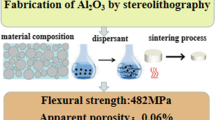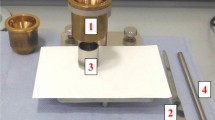Abstract
The aim of this paper is to develop a novel Solvent-based Slurry Stereolithography and Sintering (4S) process which can fabricate high strength ceramic parts. High performance solvent-based slurry, which was composed of alumina powder as a structure material, visible light curable resin as an organic binder and methanol as a solvent and a dispersant, could be prepared with colloidal processing. During layer casting, the diaphanous slurry can penetrate into pores of the subjacent layers. After drying, the binder in the penetrated liquid could connect the fresh layer and subjacent layers. Eventually, a gel-like green block could be built layer by layer. In the exposed region, the resin contained in the green block was cured to connect the alumina powders to be a part of the rigid green part. However, the un-exposed region remained gel-like and is methanol-soluble. Afterward, the green block was immersed in a methanol solution. Due to dissolving of the resin, the un-exposed region could completely collapse to obtain the rigid green part. The obtained rigid green part was then heated up to 600°C for binder burnout, and then sintered at 1600°C to obtain a dense alumina ceramic part. The results show an average tensile and flexural strength are 327 and 472 MPa, respectively, and a relative density of 98% was achieved. The proposed method of solvent-based slurry was briefly described and it was proved that the good capacity of solidifying thin layer. The results also show that the developed system can fabricate complicated rigid green parts quickly with high accuracy (less than 5 μm).
Similar content being viewed by others
References
Griffith, M. L. and Halloran, J. W., “Freeform fabrication of ceramics via stereolithography,” Journal of American Ceramic Society, Vol. 79, pp. 2601–2608, 1996.
Hinczewski, C., Corbel, S., and Chartier, T., “Ceramic suspensions suitable for stereolithography,” Journal European Ceramic Society, Vol. 18, pp. 583–590, 1998.
Chartier, T., Chaput, C., Doreau, F., and Loiseau, M, “Stereolithography of structural complex ceramic parts,” Journal of Material Science, Vol. 37, pp. 3141–3147, 2002.
Ha, Y.-M., Park, I.-B., and Lee, S.-H., “Three-dimensional microstructure using partitioned cross-sections in projection microstereolithography,” Int. J. Precis. Eng. Manuf., Vol. 11, pp. 335–340, 2010.
Park, I.-B., Choi, J.-W., Ha, Y.-M., and Lee, S.-H., “Multiple fabrications of sacrificial layers to enhance the dimensional accuracy of microstructures in maskless projection microstereolithography,” Int. J. Precis. Eng. Manuf., Vol. 10, pp. 91–98, 2009.
Subramanian, P. K., Vail, N., Barlow, J. W., and Marcus, H. L., “Selective laser sintering of alumna with polymer binders,” Rapid Prototyping Journal, Vol. 1, pp. 24–35, 1995.
Liu, Z. H., Notle, J. J., Packard, J. I., Hilmas, G., Dogan, F., and Leu, M. C., “Selective Laser Sintering of High-density Alumina Ceramic Parts,” Proceedings of the 35th International MATADOR Conference, National Taiwan University, Taipei, Taiwan, Vol. 14, pp. 351–354, 2007.
Agarwala, M. K., Bandyopadhyay, A., Weeren, R., Safari, A., Danforth, S. C., Langrana, N., Jamalabad, V., and Whalen, P. J., “Rapid fabrication of structural components,” American Ceramic Society Bulletin, Vol. 75, pp. 60–66, 1996.
Klosterman, D. A., Chartoff, R. P., Osborne, N. R., Graves, G. A., Lightman, A., Han, G., Bezeredi, A., Rodrigues, S., Pak, S., Kalmanovich, G., Dodin, L., and Tu, S., “Direct fabrication of ceramics, CMCs by rapid prototyping,” American Ceramic Society Bulletin, Vol. 77, pp. 69–74, 1988.
Cawley, J. D., Heue, A. H., Newman, W. S., and Mathewson, B. B., “Computer-aided manufacturing of laminated engineering materials,” American Ceramic Society Bulltin, Vol. 75, pp. 75–79, 1996.
Grau, J., Moon, J., Uhland, S., Cima, M., and Sachs, E., “High green density ceramic components fabricated by the slurry based 3DP process,” Proc. of the 8th Solid Freeform Fabrication Symposium, The University of Texas at Austin, Texas, USA, pp. 371–378, 1997.
Tang, H. H., “Building ultra-thin layers by ceramic laser sintering,” Material Transaction Journal of Japan Institute of Metal, Vol. 47, pp. 889–897, 2006.
Jiang, C. P., Huang, J. R., and Hsieh, M. F., “Fabrication of synthesized PCL-PEG-PCL tissue engineering scaffold using an air pressure-aided deposition system,” Rapid Prototyping Journal, Vol. 17, pp. 288–297, 2011.
Finch, C. A. and Okaya, T., “Polyvinyl Alcohol-Developments,” John Wiley, New York, pp. 6–7, 1992.
Grau, J. E., Uhland, S. A., Moon, J., Cima, M. J., and Sachs, E. M., “Controlled cracking of multilayer ceramic bodies,” Journal of American Ceramic Society, Vol. 82, pp. 2080–2086, 1999.
Author information
Authors and Affiliations
Corresponding author
Rights and permissions
About this article
Cite this article
Wang, JC. A novel fabrication method of high strength alumina ceramic parts based on solvent-based slurry stereolithography and sintering. Int. J. Precis. Eng. Manuf. 14, 485–491 (2013). https://doi.org/10.1007/s12541-013-0065-3
Received:
Accepted:
Published:
Issue Date:
DOI: https://doi.org/10.1007/s12541-013-0065-3




